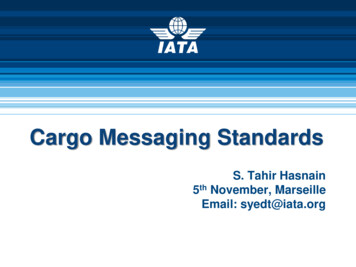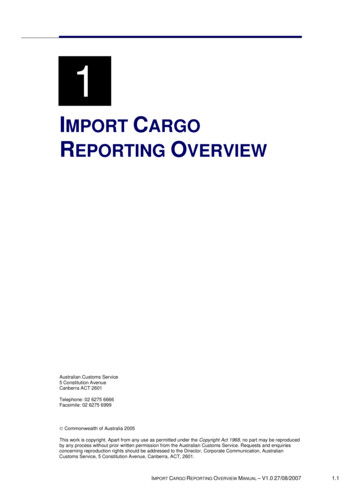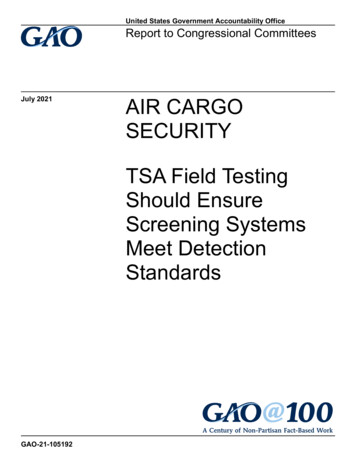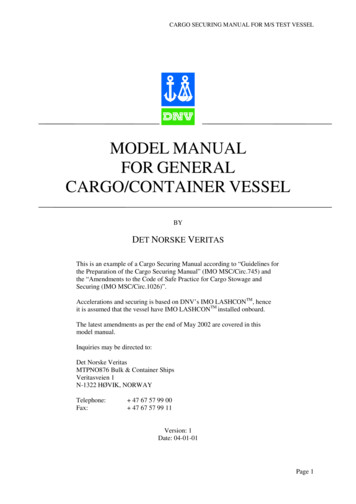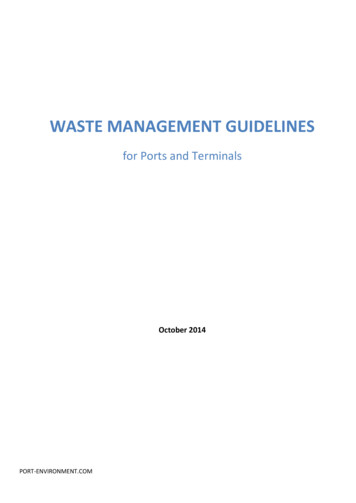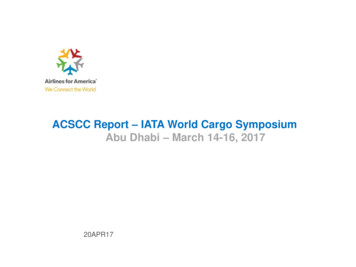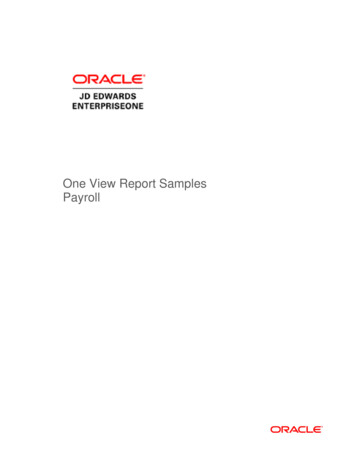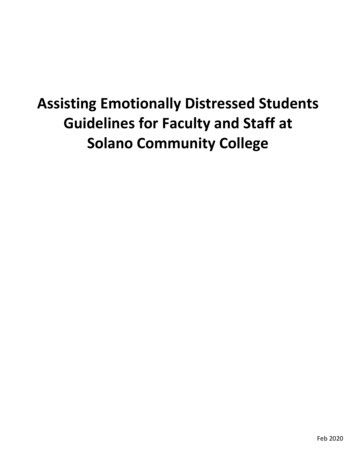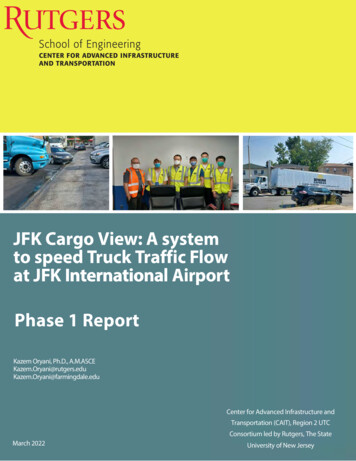
Transcription
JFK Cargo View: A systemto speed TTruckruck TTrafficraffic FFlowlowat JFJFKK IInternationalnternational AiAirporporrtPhase 1 ReportKazem Oryani, Ph.D., ngdale.eduCenter for Advanced Infrastructure andTransportation (CAIT), Region 2 UTCConsortium led by Rutgers, The StateMarch 2022University of New Jersey
CAIT-UTC-REG22JFK Truck Flow Management System (TFMS)Business Plan ProjectFINAL REPORTMarch 2022Submitted by:Kazem Oryani, PhDPrinciple Investigator (PI)Senior Research Scientistand Adjunct ProfessorCenter for Advanced Infrastructureand TransportationRutgers mingdale.eduJing (Peter) Jin, PhDCo-Principle Investigator (Co-PI)and Modelling ManagerAssociate Professor of Civil andEnvironmental EngineeringCenter for Advanced Infrastructureand TransportationRutgers Universitypeter.j.jin@rutgers.eduAndrew J. Huber, MBAAssociate and Senior ConsultantCayuga Partnersandy@cayugapartners.com1
CAIT-UTC-REG22Contributors in alphabetical order:Anjiang Chen, PhD CandidateDepartment of Civiland Environmental EngineeringRutgers Universityanjiang.chen@rutgers.eduJohn Juzbasich, D.Ed.(c), MLD, PMPAssociate and Senior ConsultantCayuga Partnersjohn@cayugapartners.comEthan Connor-Ross, MPASenior Vice President and PrincipleEconsult Solutions Inc.ConnerRoss@EconsultSolutions.comScott Grimm-Lyonn, AICPFormer Executive DirectorGatewayJFKdirector@gatewayjfk.orgJohn. A. Muckstadt, PhDFounding PartnerCayuga Partnersand Professor Emeritus, Cornell Universityjmuckstadt@cornell.eduKazem Oryani, PhDSenior Research Scientistand Adjunct ProfessorCenter for Advanced Infrastructureand TransportationRutgers mingdale.eduAndrew J. Huber, MBAAssociate and Senior ConsultantCayuga Partnersandy@cayugapartners.comMichael Shenoda, PhD, P.E.Assistant Professorof Civil Engineering TechnologyFarmingdale State Collegeshenodm@farmingdale.eduM. Nazril IslamProfessor and ChairComputer SecurityFarmingdale State Collegeislamn@farmingdale.eduJing (Peter) Jin, PhDAssociate Professor of Civil and EnvironmentalEngineeringRutgers Universitypeter.j.jin@rutgers.eduIn cooperation withRutgers, The State University of New JerseyAndGatewayJFK2
Disclaimer StatementThe contents of this report reflect the views of the authors,who are responsible for the facts and the accuracy of theinformation presented herein. This document is disseminatedunder the sponsorship of the Department of Transportation,University Transportation Centers Program, in the interest ofinformation exchange. The U.S. Government assumes noliability for the contents or use thereof.The Center for Advanced Infrastructure and Transportation (CAIT) is a Regional UTC Consortiumled by Rutgers, The State University. Members of the consortium are Atlantic Cape CommunityCollege, Columbia University, Cornell University, New Jersey Institute of Technology, PolytechnicUniversity of Puerto Rico, Princeton University, Rowan University, SUNY - Farmingdale StateCollege, and SUNY - University at Buffalo. The Center is funded by the U.S. Department ofTransportation.3
1. Report No.2. Government Accession No.3. Recipient’s Catalog No.Cait-UTC-REG224. Title and Subtitle5. Report DateTruck Management System: JFK Cargo View - Acollaborative, Airport-wide Information System toCoordinate Air Cargo Ground Operations and SpeedTruck Traffic Flow within JFK International Airport andthe Surrounding CommunityMarch, 2022T E C HN I C AL RE P O RT S T AN DAR D T I T L E P AG E7. Author(s)Andrew J. HuberJing (Peter) JinJohn A. MuckstadtKazem Oryani6. Performing Organization Code8. Performing Organization Report No.CAIT-UTC-REG229. Performing Organization Name and Address10. Work Unit No.Cayuga Partners, LLC5950 Cleary RoadLivonia, NY 1448711. Contract or Grant No.69A3551847102Rutgers Center for Advanced Infrastructure andTransportation100 Brett RoadPiscataway, NJ 0885412. Sponsoring Agency Name and AddressCenter for Advanced Infrastructure and TransportationRutgers, The State University of New Jersey100 Brett RoadPiscataway, NJ 0885413. Type of Report and Period CoveredFinal Report5/18/2021 – 12/31/202114. Sponsoring Agency Code15. Supplementary NotesU.S. Department of Transportation/OST-R1200 New Jersey Avenue, SEWashington, DC 20590-000116. AbstractThis study was conducted by the project team from April 2021 to December, 2021. GatewayJFK andthe Center for Advanced Infrastructure and Transportation (CAIT) at Rutgers University jointly fundedthis study. During the study period, several site visits and interviews of stakeholder were conductedby project team members in the off-airport GatewayJFK district and JFK Airport facilities to obtaininput from stakeholders and observe operations. These include on-airport cargo ground handlers,off-airport transportation companies (including their truck drivers), and residents. In addition, severalvisits were made to the district to observe truck movement and business activity in the area, andresidential uses impacted by the adjacent warehouse and logistics properties. Online and in-personsurveys were conducted to gauge stakeholder satisfaction and insights as well the difficulty of getting4
to JFK Airport Area, level of congestion experienced, and delays related to the loading/unloading ofcargo on-airport, and the challenges inherent within the off-airport GatewayJFK district . Thepreliminary results of this Phase I study are a compelling business case for an airport wide Truck FlowManagement System (TFMS) and a list of future investments to retain and grow air cargo business atJFK Airport, and to enhance and support the on- and -off-airport synergy vital to the world’s supplychain17. Key Words18. Distribution StatementKey wordsAir cargo, congestion, truck flow, dieselemissions, dock scheduling, logistics19. Security Classification (of this report)20. Security Classification (of this page)21. No. of PagesUnclassifiedUnclassified20722. PriceForm DOT F 1700.7 (8-69)5
The study team would like to thank Dr. Ali Maher, Professor and Director of the Centerfor Advanced Infrastructure and Transportation (CAIT) at Rutgers University for hisguidance provided throughout the study period.Efforts of the staff at CAIT for supporting this study is highly appreciated.The study team would also like to thank Frank Liggio, GatewayJFK Chair, along withScott Grimm-Lyon, former Director of GatewayJFK for their leadership, participation,guidance, and financial support of our study.Rutgers Center for Advanced Infrastructure and Transportation (CAIT) tackles some of the country’s mostpressing infrastructure challenges, especially those that are endemic in high-volume multimodal corridors like theNortheast.The bulk of our efforts fall within several broad areas: assessing and monitoring the health of bridges, roads, andpipelines; creating revolutionary technologies, materials, and tools; formulating strategies to prolong the servicelife of infrastructure; and training the current and future workforce.CAIT develops practical tools and processes that can be applied—not in theory, not on paper, not five years in thefuture—but as mainstream tools in the hands of transportation professionals solving real-world problems rightnow.Since 1998, CAIT has been a University Transportation Center (UTC)—an elite group of academic researchinstitutions sanctioned and supported by the U.S. Department of Transportation. It was named one of only fiveNational UTCs in 2013 and selected to lead the Region 2 UTC in 2018.GatewayJFK – Off Airport. On the Move. GatewayJFK is the off-airport cargo community that is a vital link in theglobal supply chain. It provides logistical support to the tons of goods that flow through JFK Airport and majorocean ports of call each year and is essential to the daily lives of New Yorkers, the nation and the world.Accessed from Rockaway Boulevard, GatewayJFK is home to over 600 businesses and almost 8,000 workers andoccupying approximately 4.1 million square feet of industrial and commercial buildings. The cargo relatedbusinesses exist alongside other light industrial and retail uses, hotels, community service and governmentfacilities as well as 154 single family homes. Without question, GatewayJFK represents a distinct, unique New YorkCity neighborhood.6
DedicationThis project is dedicated to our friend and colleague Walter H. Beadling III. For many years Walt wasinvolved with the air cargo community at JFK airport. As he learned about the ongoing and increasingproblems caused by truck congestion and the declining air cargo market share, he decided somethingneeded to be done. For nearly a decade he doggedly pursued the idea of exploring whether a systemcould be put in place to alleviate truck congestion.Our friend suffered a fatal heart attack in the middle of this Phase I Feasibility Study, just as he waspreparing for our weekly team meeting. The entire team decided we should continue the project andtry to complete it the way Walt would have wanted. We hope he would have been pleased with ourwork.7
Executive SummaryFrom May 2021 – December 2021 we conducted a feasibility study for a Truck Flow Management System (TFMS)for air cargo supply chain participants in and around JFK International Airport. The project was sponsored by theCenter for Advanced Infrastructure & Transportation (CAIT) at Rutgers University and GatewayJFKi. The studyteam included researchers from Rutgers University, Farmingdale State College (SUNY), Cayuga Partners, andEconsult Solutions Inc. (ESI).The primary objective of a Truck Flow Management System is to reduce truck wait times and congestion at JFKairport. The project was envisioned to have four phases:1. Establish Business Case and Plan2. Acquire TFMS (Make and/or Buy)3. Develop and Deploy4. Operate and MaintainOur conclusions from Phase 1 are:1. Based on the results obtained from an online survey, interviews with truck drivers, shipment data fromAlliance Ground International, our prototype simulation, and truck telematics data, we have confirmedthat:a. Truck wait times at the airport are excessively long.b. Truck congestion is significant both on and off the airport.c. Waiting trucks can produce excessive diesel emissions, known to cause serious health issues.2. There is an overwhelmingly positive business case for a TFMS based on the potential savings related toreducing truck wait times.3. Commercially viable TFMS solutions are available.4. An airport wide TFMS is required to maximize achievable benefits.5. There are other more serious deficiencies in air cargo operations at JFK airport. Significant financialinvestments must be made to prevent continuing decline in air cargo business at JFK.A common airport wide TFMS would provide a single process for all freight forwarders, ground handlers andtruckers. For imported cargo, the TFMS would report when cargo has been broken down and ready for pickup,when the trucker is scheduled to pick up the cargo, and when the cargo has been loaded onto a truck. Based onour surveys, forwarders, truckers, and customers are frustrated by the inability to track cargo shipment status ina timely manner.To stem the decline in air cargo business at JFK, the following are imperative: Adopt and integrate information technology solutions across organizations. Reengineer road access into and within JFK including a truck marshalling yard. Construct modern cargo handling facilities with ready access to flights. Recruit, train, and increase pay to retain cargo-related employees. Automate ground handling operations to move cargo faster and with less labor.The recommendations listed above are long-term and require significant expenditures. A Truck FlowManagement System however is not that costly and can bring shorter term improvements to the airport.8
ContentsIntroduction .101.Background and Project Objectives .122.Principles of Supply Chain Management: Implications for Airport Cargo Operations .183.Online Stakeholder Survey Findings .234.Trucker Interview Findings .325.GatewayJFK and the Springfield Gardens Community .366.A Prototype Simulation for Air Cargo Operations .447.Improving Navigation and Cargo Security in and Around the Airport .708.Requirements for a Truck Flow Management System .749.Software Vendor Evaluations .7710. Benefits to JFK Air Cargo Community Stakeholders .8511. The Business Case for Improved Truck Flow .8812. TFMS Implementation Planning Recommendations .10313. Summary and Conclusions .109Appendix A: JFK Air Cargo Management Stakeholder Survey Results .111Appendix B: Truckers Survey Report .136Appendix C: GatewayJFK Airport Network Geometric Deficiency Analysis .148Appendix D: JFK Cargo View: A System to Speed Truck Traffic Flow at JFK Airport .176Appendix E: American Airlines JFK Cargo Handling Observations .180Appendix F: Interview Notes: Joe Clabby, CEO, Corporate Loss Prevention Associates .199Appendix G: Project Site Visits, In-Person Meetings, .2019
IntroductionIn this document we report the team’s observations and findings concerning the feasibility of deployinga Truck Flow Management System (TFMS) at John F. Kennedy International Airport (JFK) for the purposeof reducing truck wait times and congestion.The first section contains background information and project objectives. We also describe theoperational cargo environment at JFK Airport, the current state of cargo operations at the airport, andthe need for improved information technology needed to manage the flow of air cargo.The second section begins with an overview of the “Five Principles of Supply Chain Management” uponwhich the consulting practice of Cayuga Partners is based. It has been our experience that thesePrinciples, as identified by our founder, Dr. Jack Muckstadt, have wide applicability to supply chainchallenges in a variety of industries. In this section we describe how the Five Principles apply to aircargo operations and must be considered if we are to deploy a Truck Flow Management System (TFMS)that will have the desired effect of reducing wait times and congestion at JFK.Key findings from an online survey we conducted with a sampling of JFK air cargo participants arepresented in Section 3. The responses and comments made by survey participants provide insight tosignificant levels of dissatisfaction and guidance on addressing concerns. Their responses indicate that aTFMS will address some, but not all, causes of dissatisfaction.Summaries of a small sample of trucker’s interviews are presented in Section 4. Trucker comments areconsistent with those from the online survey.The fifth section profiles GatewayJFK, the off-airport cargo community located directly east of JFKairport. It also contains observations of cargo activities within the airport as well. These observationsand overview are based on a tour of the area given to Kazem Oryani by former GatewayJFK ExecutiveDirector Scott Grimm-Lyon.Section 6 contains a report on the Prototype Simulation developed by Peter Jin and his PhD Students.The purpose and functionality of the simulation as well as preliminary results are presented. Thesimulation is a valuable tool for quickly and inexpensively evaluating changes in operating conditionsand practices.Section 7 is a summary of reports by Michael Shenoda and Nazril Islam about the road network andconditions within the GatewayJFK district, the usability of GPS navigation on the airport, and a proposalfor a secure cargo truck monitoring system at the airport. The complete reports can be found inAppendices C and D.In the eighth section, we present system requirements for an air cargo TFMS. We also discuss aquantitative model evaluating the applicability of commercially available solutions to the JFKenvironment. The detailed requirements are contained within the model itself, which is documented in10
the Excel file TFMS Software Requirements and Vendor Evaluations.xlsx. The requirements identified arecategorized by system components and prioritized to differentiate needs from wants. The model canserve as a basis for soliciting information and proposals from potential software suppliers for a TruckFlow Management System.The ninth section contains overviews of the commercial applications, including several that we electednot to evaluate in detail. The findings provide guidance for vendor negotiations and final selection.Section 10 presents a business case and ecological benefits for deploying a Truck Flow ManagementSystem. The business and ecological impacts were derived by Ethan Connor-Ross and are reported inSection 11.Benefits of employing a TFMS to JFK air cargo community stakeholders are listed in Section 10. Thebusiness and ecological benefits are further defined and quantified by Ethan Connor-Ross in Section 11.In Section 12 we introduce important implementation considerations for future phases to deploy aTFMS. The considerations represent keys to success of IT-driven supply chain transformations that mustnot be ignored.We end with a summary and conclusions.11
1.Background and Project ObjectivesOur project findings are based on observations made from April to December 2021.During 2013, an ad hoc committee of JFK air cargo community members was formed to examine avariety of air cargo issues at the airport. The committee was specifically concerned about thesechallenges: SecurityMotor freight congestionTruck wait timesCargo theftTerrorismThe committee consisted of the following members: Walt Beadling, Cargo Security Alliance; Cayuga Partners LLCBob Caton, President, JFK Airport Chamber of Commerce; Prologis Inc.Joe Clabby, KAAMCO Security Team Leader; CEO, Corporate Loss Prevention AssociatesPeter Debenigno, KAAMCO Trucking Industry Team Leader; Mobile Air TransportJoel Ditkowsky, JFK Customs Brokers & Freight Forwarders AssociationStefano Pascucci, Executive VP, Business Development, Airport Plazas Inc.Joe Pesce, Chairman, KAAMCO Cargo Operations Committee; Air FranceDon Rivas, Port Authority NY & NJVida Shaver, IT Manager Cargo Airport Services (CAS)The committee’s concerns were supported by a study conducted by the New York City EconomicDevelopment Corporation and the Port Authority of New York and New Jersey that was reported in theWall Street Journal1. That study found that:1. Rising costs, traffic congestion and truck wait times are driving air cargo business away from JFK.2. From 2004 to 2009, JFK air cargo related jobs fell from 50,000 to 30,000; wages from 3 billionto 1.75 billion; and sales from 8.5 billion to 5.2 billion.3. Trucking, logistics companies and drivers try to avoid JFK when they can; “. . . one of the mostcostly places to conduct business in the ground transportation industry.”1JFK Declines as Air Cargo Destination, Wall Street Journal, February 24, 201312
Since 2013, the air cargo business environment at JFK has changed substantially: The COVID-19 pandemic demonstrated the importance and value of air cargo to air carriers andthe NYC Region.New Federal Motor Carrier Safety Administration Hours of Service (HOS) Regulations haveconstrained truck capacity, impacting the amount of time a driver can wait to pick up or drop offcargo.Mandatory 100% inspection regulations from the Transportation Security Administration haveadded to processing times in moving cargo through ground handling operations.These events and the issues raised by the ad-hoc committee in 2013 must be addressed. The presentenvironment has both detrimental economic and environmental consequences.The Air Cargo Environment at JFKThe diagram below depicts a high-level flow of how cargo currently moves from aircraft at the airport.As the Legend indicates, the green boxes represent activities at the aircraft, orange represent groundhandling activities, and blue represent truck activities. The red ovals represent the flow of informationthat trigger the movement of cargo.After an arriving flight lands, the ground handler sends a dolly train to the aircraft where the cargo isunloaded from the aircraft and onto the dollies. The cargo is then trailered to the ground handlingfacility where it is unloaded from the dollies and broken down into individual packages for customsclearance. The cargo is then typically placed in temporary storage awaiting pickup. Once a truck arrives,they must check in and pass security checks. The trucker must then wait until the cargo is available, anda forklift, forklift operator and loading dock are available. The cargo is then removed from temporarystorage and loaded onto the truck.13
Dolly trains at a landing siteAirlines have information systems that track the flow of cargo from the departing airport to the arrivingairport. Typically, freight forwarders, customs brokers and their customers can go to the airline’swebsite to track flights by cargo airway bill number. Thus, they can be notified when the flightcontaining the cargo has landed. Fully integrated carriers like Amazon, FedEx, UPS and DHL haveinformation systems that track the flow of cargo all the way to the end customer.For other airlines however, there are no information systems to indicate when the cargo is ready at theground handling facility for pickup. The only way a forwarder or trucker can find out if the cargo is readyis by calling the ground handler on the phone or by going to the airport and checking in at the groundhandler facility. Our survey results indicated that ground handlers are often short-staffed and not ableto answer the phone. Ideally, trucks would arrive when the cargo, a forklift and operator and dock areall available so that wait times would be minimized. However, without an information system to notifythe truckers when the cargo can be loaded, they can only try calling or go to the airport after the flighthas landed. This generally results in trucks arriving at the airport after the cargo has landed but notknowing if the cargo is yet available for pickup. As a result, drivers often must wait for hours before thecargo can be loaded onto their trucks.A Truck Flow Management System would provide this important missing information. Forwarders andTruckers would be notified when the cargo is available for pickup, and they would be given theopportunity to reserve a dock and time slot. The trucker could then arrive at the scheduled time withlittle to no wait time.Similarly, the next diagram depicts a high-level flow of how cargo moves from trucks to aircraft. Theprocess is initiated by forwarders or customs brokers who arrange to have cargo transported for acustomer. Ground handlers require cargo to arrive with enough time for them to prepare the cargo forits scheduled flight. Trucks then transport the cargo from the customers to the ground handling facility.14
After arriving, drivers check in as they do for picking up cargo. The ground handling agent then assigns adock for unloading when a dock, forklift, and forklift driver are available to receive the cargo. The cargois then received and stored temporarily until mandatory TSA scanning can be performed. Scanned cargois stored separately from cargo awaiting scanning. Cargo is then built up on pallets or loaded intocontainers prior to being transported to an awaiting aircraft on dolly trains.As with the import process, truckers currently experience long wait times with the export process.When the trucks arrive at the airport, the truckers do not know whether the ground handling facility hasa dock, forklift, and forklift driver available to unload the cargo. If those resources are being consumedby other cargo, the driver must wait. Cargo drop-offs for export are given priority over pickups forimport to ensure that shipments do not miss their flights. This prioritization can increase wait times forpickups.A Truck Flow Management System we envision would reduce wait times for both import and export. Byscheduling dock reservations prior to transporting cargo to the airport, truckers would be assured that adock, forklift, and forklift driver will be available, thereby reducing or eliminating wait time. Theproposed process changes with a TFMS are depicted on the following page for both the import andexport processes.Note the important changes. For import, drivers schedule a dock time following notification that thecargo is ready for pickup. Furthermore, the scheduled time of arrival ensures that a dock is available forthe pickup activity to occur. Similarly for export, drivers would not need to wait at the airport for a dockassignment. They would schedule a time to arrive when a dock would be available. Thus, with a TFMSsystem, wait times are significantly reduced or eliminated for both import and export, greatly reducingtruck congestion at the airport and lessening the environmental impact of idling trucks.15
Our Project ObjectivesOur project was initiated in 2021 to further study the congestion problem and to outlinerecommendations for community action. The project was sponsored by the Center for AdvancedInfrastructure & Transportation (CAIT) at Rutgers University and GatewayJFK .16
The high-level project objectives are to study how to: Minimize cargo truck wait times and traffic congestion at JFKAirport.Ensure a secure, traceable, verifiable chain of custody for JFKair cargo to prevent cargo theft and counter terrorism.Reduce logistics costs, make JFK airport more competitive asan international air cargo hub, attract new business, createjobs, and deliver economic benefit and growth to thecommunities surrounding JFK airport in particular NYC, and the region.While many initiatives must ultimately be undertaken to improve daily operations and economicactivity, a first, and essential, step is to deploy an airport wide Truck Flow Management System (TFMS).This system would:1. Provide a mobile app for truckers.2. Integrate with other critical air cargo applications with Electronic Data Interchange (EDI)messaging.3. Schedule truck arrivals collaboratively.4. Facilitate truck staging and temporary parking during peak times and when multiple Less-ThanLoad (LTL) drop-offs and pick-ups occur.Since we began this project, the urgency to improve air cargo operations has increased, as evidenced by: Air cargo volumes at JFK having increased 30% over 20202Historic staffing shortagesExisting Infrastructure not being able to process cargo volumes in a timely mannerTSA’s introduction of 100% Freighter Screening on July 1, 2021Nearly 90% of the JFK Air Cargo Survey participants rated wait times at JFK as being worse or muchworse than other airports3. When asked to rank potential solutions to improving wait times at JFK,“Improve Information Technology” was the 2nd ranked solution behind “Increase cargo handlingcapacity”.This section authored by:Andrew J. HuberJohn A. MuckstadtCayuga Partners2Improving Air Cargo Throughput: The Challenge for Handlers, Airports and Their Stakeholders, Air ForwardersAssociation Webinar, 2021.32 See Appendix A: FK Air Cargo Management Stakeholder Survey Results17
2. Principles of Supply Chain Management: Implications forAirport Cargo OperationsThe performance of a supply chain is influenced by the structure of business processes, informationsystems, and decision support rules as well as the nature of collaboration between supply chainpartners. When designed poorly, as measured by managerial and physical attributes, incrementalimprovements will have little impact. A competitive advantage will exist only if several key elementsexist in a supply chain. Our many years of consulting experience have consistently revealed fiveprinciples that must guide the development of an effective supply chain.These Principles have been found to be required for maximum supply chain effectiveness in a widevariety of industries including manufacturing, retail, service operations, petroleum, transportation, themilitary and most recently in health-related systems They are equally as applicable to air cargooperations and must be considered if we are to reduce wait times and congestion at JFK airportsignificantly.1.Know the customer.First and foremost, without a clear understanding and definition of customer needs and desires,a supply chain cannot be effectively constructed. To gain this understanding, the project teamhas undertaken several activities to gain an
Management System (TFMS) and a list of future investments to retain and grow air cargo business at JFK Airport, and to enhance and support the on- and -off-airport synergy vital to the worlds supply chain 17. Key Words Key words Air cargo, congestion, truck flow, diesel emissions, dock scheduling, logistics 18. Distribution Statement 19.
